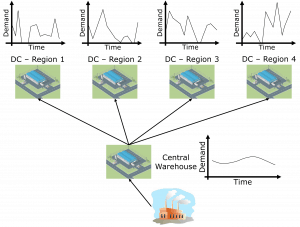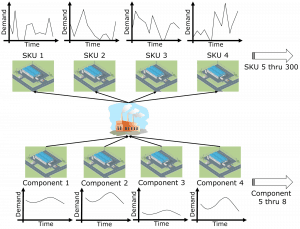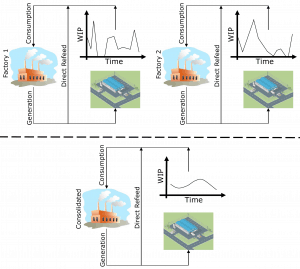Production variability and demand variability causes congestion in supply chains. One way to reduce this congestion is to reduce the variability by addressing its causes.
Another and more subtle way to deal with congestion is by combining multiple sources of variability. This is known as variability pooling, and has a number of supply chain applications. There are two types of Variability Pooling; Queue Sharing and Stock Aggregation and in this article we explore the concept of Stock Aggregation.
Stock Aggregation is of enormous importance in inventory management. The most important factor in benefiting from stock aggregation in a supply chain is deciding where best to place inventory.
Below we explore three types of stock aggregation; Demand Consolidation, Component Pooling and Rework Containment.
Demand Consolidation
Consider the demand profile at different points in the supply chain for a product from the factory below. The demand profile at each of the distribution centres is very erratic and it would require very large stock positions at each of the centres to ensure that they didn’t have stock-outs for this product.
If on the other hand, we simply set up a one-to-one relay at each of the centres with a modest amount of safety stock for delivery times (from Central Warehouse to DC), then we could consolidate most of our safety stock back to a central warehouse.
This would signicantly reduce the inventory required to maintain customer service for this product with all the positive impacts that this would have on the Balance Sheet and the P&L statement. Of course not all products from the factory would exhibit this behaviour but it illustrates the point.
Component Pooling
To illustrate Component Pooling we have altered the diagram above only slightly to demonstrate demand behaviour for a factory that produces 300 SKU’s with only 8 components/raw materials.
When variability is pooled at the component level it is much smoother and therefore stock positions here, rather than at the finished goods SKU level, will be much smaller.
Obviously this is also a simplistic view primarily because the implication of winding back our stock positions further up the supply chain must be considered. For example what are the customer service and leadtime implications for doing this?
These sorts of issues can be sorted out with robust supply chain design and, while inventory positions at the component level may need to be increased slightly, the positive impact on business inventory holdings and therefore cash positions can be very high.
Rework Containment
Consider 2 factories below owned by one company. The factories produce similar products with low raw material yeilds requiring significant resources devoted to rework management.
Continuous improvement efforts continue at each site however effective management of rework at both sites is an ongoing reality and an activity that consumes considerable resources in terms of handling, planning, management and WIP inventory.
The graphic below shows the results of consolidating all the rework generating and consumption assets to a single site. This has the effect of statistically increasing the number of opportunities for refeed and, by virtue of variability pooling, reducing the WIP inventory holdings.



